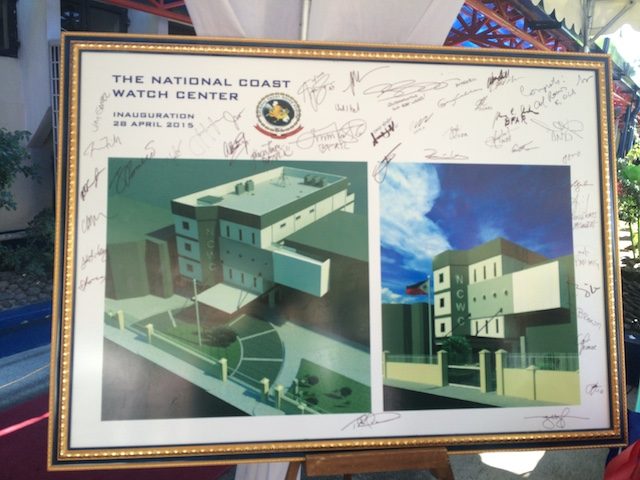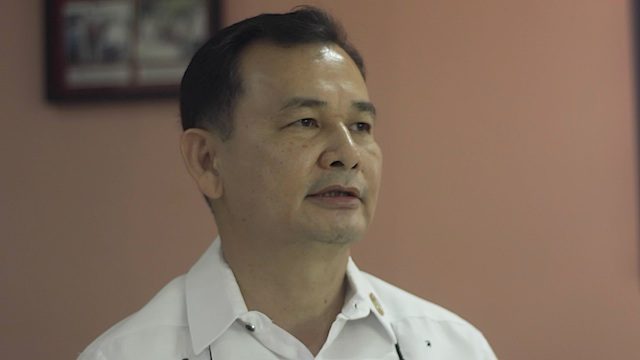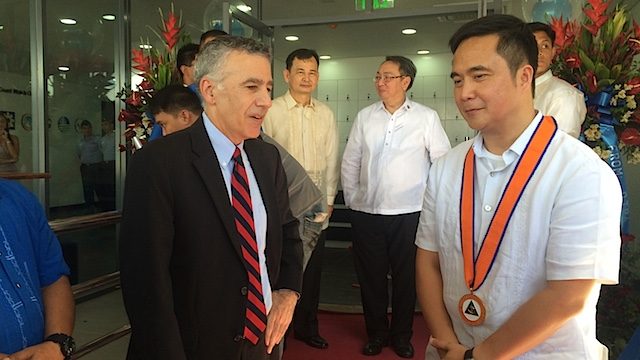SUMMARY
This is AI generated summarization, which may have errors. For context, always refer to the full article.

MANILA, Philippines – “This, ladies and gentlemen, is the command center. Welcome aboard,” the navy officer told reporters Tuesday afternoon, April 28, as he ushered them into the most important room in the newly-inaugurated National Coast Watch (NCW) Center in Manila.
No cameras were allowed inside the facility built and primarily funded by the Americans.
One of the screens on the wall showed blue lines sketching the Manila Bay coastline and dozens of triangles representing docked and sailing ships inside its waters. One of the triangles was highlighted in a computer. The information that popped up provided the vessel’s location and other details. “Friendly,” read one of the tabs.
Another screen showed the map of the Philippines while two others were turned off.

“[The Center is] a physical expression towards the realization of our goals and dream of the establishment of the National Coast Watch Center,” Undersecretary Jose Luis Alano, executive director of the NCW Council Secretariat, said in his speech at the building’s inauguration ceremony earlier that afternoon.
Alano is a former chief of the Philippine Navy.
Executive Order 57 envisioned the construction of the Center in 2011 as the brain center for the country’s maritime law enforcement operations. It is meant to pool maritime surveillance data from the Navy, Coast Guard, Bureau of Fisheries, and police Maritime Group, among others, to provide a complete picture of what’s happening in Philippine waters and enforce the country’s maritime laws.
But it’s only Phase 1 for now – the center does not yet see the entirety of the country’s long coastline; so far only spanning the waters of the country capital Manila and the waters of Palawan, the province facing the volatile West Philippine Sea (South China Sea).
“It shall be equipped with the needed capabilities to achieve maritime situational awareness, coordinated inter-agency response, and disposition in accordance with the rule of law. This will be done in phases until full-mission capability is achieved,” Alano added.
In times of crisis
The National Coast Watch Center should pave the way for quicker detection of threats and arrest of criminals sailing the country’s waters – human and drug trafficking, terrorism, weapons of mass destruction, destruction of natural environment, overharvesting of endangered marine species, and even natural disasters.
It aims to fill in the gaps left by poor equipment and fix overlaps in government response. There are government agencies that act without prior consultation and are sometimes more interested in securing the primary role in government operations than supporting the best solution to the problem.

There’s a situation room on the first floor of the building, where the representatives of different government agencies can gather, analyze information fed to a big screen by the command center, and agree on a decisive response.
If the Bureau of Fisheries, for example, is not present at the site of an illegal fishing incident, it can deputize the government agency in the area to make the arrest and at the same time remain on top of the situation.
Alano explained that the NCW Council deals primarily with non-state actors. He opted to highlight its value in the country’s campaign against smuggling and terrorism. But in case of a “crisis” at sea, Alano said the Center can provide the appropriate government agency the necessary information to call the shots.
“If the situation heightens to become a crisis or something even higher, then we give it to the necessary agencies that need to handle it….We have a link-up with them and pass on all the information we have to include the necessary support units they will need in order to perform their mandate,” Alano said.
In case of a natural disaster, the Center can send all the necessary information to the National Disaster Risk Reduction and Management Council (NDRRMC).
In extreme cases, the information can be sent to Malacañang.
US and the West PH Sea
It took 4 years and a lot of assistance from the US Defense Threat Reduction Agency (DTRA) to build the facility inside the headquarters of the Philippine Coast Guard. It was constructed by US government defense contractor Raytheon.
Alano deliberately veered away from talking about the Philippines’ maritime dispute with China. It was US ambassador Philip Goldberg who spoke of the sea disputes and upheld the peaceful resolution of the conflict.
In his speech, Goldberg described the National Coast Watch Center as “a shared effort of the US and the Philippine government” and “a step toward the realization of a safe and secure marine environment.”
“Domain based not on might makes right or grab what you can but on a common understanding that an order rooted in economic, openness, stewardship of the environment, peaceful resolution of disputes and respect for universal rights and freedom provide the best guarantee for peace justice and stability,” Goldberg said.

The US interest in the South China Sea is primarily economic. It has expressed concerns that China’s militarization of the major trade route could affect freedom of navigation.
The US has slammed China’s reclamation activities in the South China Sea, which the Philippine military fears will develop into military outposts meant to cut Philippine access to its claimed areas in the disputed territory.
The Philippine bureau of fisheries also recently warned of P4.8 billion in economic losses to the Philippines because the Chinese reclamation on 5 reefs buried 311 hectares of coral reefs.
The inauguration of the National Coast Watch Center coincides with the first anniversary of the Enhanced Defense Cooperation Agreement (EDCA) – signed on April 28, 2014 – that is still pending before the Supreme Court over constitutionality issues.
“This is Philippine property,” the American representative of Raytheon told reporters inside the command center, dismissing a question on US access to the center’s surveillance data.
EDCA allows the US military to build its own facilities and keep its assets such as ships and aircraft inside assigned Philippine military bases offered to them under the agreement. It is de facto basing, according to its critics.
That is the main difference between the facility built inside the headquarters of the Philippine Coast Guard and the facitilies that the Americans plan to build under EDCA. – Rappler.com
Add a comment
How does this make you feel?
There are no comments yet. Add your comment to start the conversation.